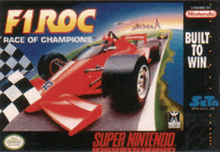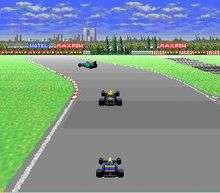Exhaust Heat
| Exhaust Heat F1 ROC: Race of Champions | |
|---|---|
 North American box art | |
| Developer(s) | Seta |
| Publisher(s) | |
| Programmer(s) | Tetsuo Mochizuki |
| Composer(s) | Masanao Akahori (Opus Corp.)[1] |
| Series | F1 ROC |
| Platform(s) | SNES |
| Release date(s) | |
| Genre(s) | Racing |
| Mode(s) | Single-player |
Exhaust Heat (エキゾースト・ヒート), released in North America as F1 ROC: Race of Champions, is a 1992 racing video game developed by Seta Corporation for the Super Nintendo Entertainment System.
The following year, the game was followed up with F1 ROC II: Race of Champions.
Gameplay

There are sixteen open wheel racing tracks in the game; all of them corresponding to the 1992 Formula One season, with races all over the Earth. Realistic looking advertisements are present where the audience sits complete with near-perfect spelling of sponsors; this mild level of censorship applies because some of the sponsors are tobacco or alcohol-related. The game uses the Super Famicom's Mode 7 to give the track and background perspective.
Players have a limited amount of money to modify their race car before having to qualify and eventually try to win the race. Modifications must be purchased out of the player's pocket like if he were a driver/owner. As with F1 rules at the time, no refueling was possible; pit stops are only used to fix damage on the automobile. Post-race damage penalties will occur if the player finished the race with a damaged vehicle. Even a minor dent can be expensive to a rookie because of the high level of marksmanship by the mechanics. Total damage can and will force the player to retire from the race. The player can choose to hide his stats (in order to look at the backgrounds) or view his stats in order to find out whether he is winning or not.
Reception
| Reception | ||||||||
|---|---|---|---|---|---|---|---|---|
| ||||||||
In an import review for Mean Machines, Julian Rignall cited Exhaust Heat as "one of the most rewarding, enjoyable and long-lasting racing games around", although he noted that "there no trackside obstacles and the game has a rather sparse and empty feel about it." Radion Automatic also praised the game, writing that "[e]ven non-race fans will be converted by this stunning release."[4] Writers for Famitsu called Exhaust Heat an "easy type of F-Zero".[2]
References
- ↑ "Composer information". SNES Music. Retrieved 2012-08-08.
- 1 2 3 エキゾースト・ヒート まとめ [スーパーファミコン]. Famitsu (in Japanese). Kadokawa Corporation. Archived from the original on 5 February 2016. Retrieved 5 February 2016.
- ↑ "Super NES Games" (PDF). Nintendo of America. Archived from the original on 25 October 2015. Retrieved 25 October 2015.
- 1 2 "F1 Exhaust Heat review" (PDF). Mean Machines. No. 19. EMAP. April 1992. pp. 80–82. Archived from the original on 5 February 2016. Retrieved 5 February 2016.